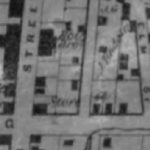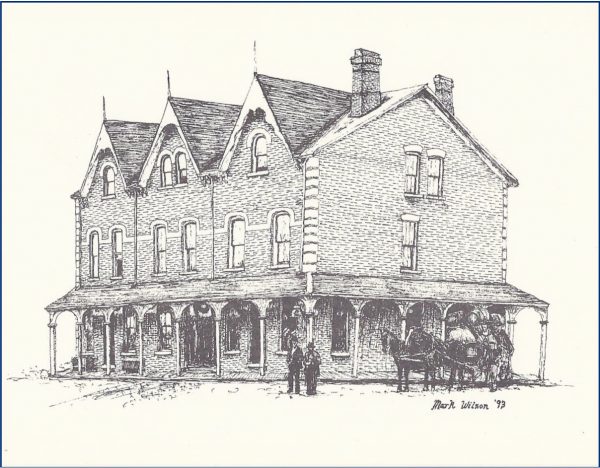Bolton has had a large number of hotels and hotel owners/operators over the years. As well, some hotels have changed names. The list of hotels identified so far include:
- Early Inn circa 1834
- Sterne’s Hotel
- Evan’s Tavern
- Exchange Hotel
- Queens Hotel
- James Wolfe’s Inn
- Tavern on King Street
- Albion Hotel
- Ontario Hotel
- Railway Hotel
Rodger’s Inn
Built: circa 1834 Construction: log Owner: Thomas Rodgers Operated until at least 1845
- In 1834, an advertisement by Thomas Rodgers for a Livestock Fair in Bolton offered ‘accommodation’ for attendees
- Rodgers, a blacksmith, had settled on Lot 14 Concession 6 around 1831; by 1834, he had built a smithy and a tavern on Mill Street on land provided by George Bolton
- The Inn, apparently the earliest, was one of the half- dozen log buildings in the clearing around Bolton Mills at that date
- Rodgers held many ‘hats’ and in 1836-37 was the Constable for Albion Township
- Local resident Elijah Harsent possibly ran the Inn for Rodgers. Harsent owned land down the street purchased from George Bolton in 1833, his daughters Mary Ann and Elizabeth were pupils in the 1842 school and he held a tavern license for 1844.
And the building?
- The Inn was the first inn in Bolton and the earliest on the site. The building was replaced in the early1850s by James Wolfe’s frame Inn.
Sterne’s Hotel
Built: circa 1840 Construction: mud brick Owner: Samuel Sterne to 1850 S Sterne Estate ~1860s Wm Hassard to 1872 Mary Ann Hassard to c1880 Operated until: circa1880 Known as: Sterne’s Hotel Hassard’s Hotel Railway Hotel

- By 1840, when Samuel Sterne built his hotel, Bolton had 14 log buildings, two blacksmiths, two shoemakers, one tailor as well as the grist mill. His hotel, however, was made from mud bricks
- The hotel was well known for its bar (perhaps coincidently, Sterne Sterne also operated a distillery) and the hotel housed the Post Office until 1849
- Sterne died in 1850. The hotel was possibly managed by his son-in-law Thomas C Starrett, an Albion farmer who, in the late -1850s, owned the Masonic Arms hotel. By 1860, Sterne’s son William would have been old enough to run it
- In the late 1860s, the hotel was purchased by William Hassard. Hassard died in 1872, age 36, leaving his wife Mary Ann and 4 young children
- Mary Ann hired John Corliss to run the hotel and it was re-named the Railway Hotel, a nod to the Toronto & Grey Bruce Railway line which started passenger service to Bolton in 1871
And the building?
- The stables and sheds burned down in 1872 shortly after Hassard’s death
- The mudbrick hotel burned down around 1880. It was replaced by the Doig Block, a group of brick buildings that still stand today
Evan’s Tavern
Established: circa 1844 Construction: log Owner: George Evans Operated until: 1847
- Brothers George and John Evans emigrated from Ireland in the late 1830s. As younger sons and both educated, they were looking to improve their lot and took up farming north of Caledon East
- John loved the land and readily agreed to farm George’s adjoining 100 acres; and so, it followed, that George set out for the ‘bright lights’ of Bolton in 1842
- Trained as a shoemaker George built a log cobbler’s shop on the corner of Queen Street and Sterne
- Two years later, discovering that profit from booze trumped making boots and shoes, George converted his log shop into a TAVERN!
- Success followed and 3 years later, he built a hotel on the site. George could glad-hand with the best
And the building?
- The log cobbler’s shop/tavern may have become an outbuilding on the hotel site
Exchange Hotel
Built: circa 1847 Construction: brick Style: unknown Storeys: 2 Owner: George Evans Operated until: 1881

- In 1847, shoemaker George Evans built a 2 storey brick hotel called the Exchange Hotel on the site of his Tavern
- The bricks were made locally at Matthew Gray’s Brickyard (later Norton’s)
- The hotel was Bolton’s finest with many bedrooms, sample rooms for commercial travellers, a large dining room, a spacious bar as well as stables
- A larger-than-life figure, Evans was involved in many community roles (see biographical notes)
- From 1868-80, George Evans took on the role of Postmaster, with the hotel serving as the ‘Albion Post Office’
And the building?
- The Exchange Hotel burned down in 1881
- George Evans quickly replaced the building with a much larger and opulent hotel
Johnston’s Inn
Built: circa 1848 Construction: frame Exterior: roughcast plaster Style: Georgian Storeys: 2 Owner: James Johnston to 1858 Sterratt/Hill to 1860 Wm Curliss to 1899 T. D Elliott to 1906 Known as: Johnston’s Inn Masonic Arms Hotel Balmoral Hotel

-
- James Johnston built a 2 storey inn in 1848. The 1851 census describes him as an Innkeeper.
- The inn is marked on the 1859 Tremaine Map as are the stables and sheds to the rear.
- The inn was purchased in 1860 by 35 year old William Curliss. Several Masonic groups regularly held meetings there and Curliss, a Blue Lodge member, loyally re-named it the Masonic Arms Hotel
- The hotel was quiet with a small bar offering the best quality liquor
- An interesting note: Curliss, a stone mason by trade, built the John Shore House on Coleraine Drive. When Shore couldn’t pay, Curliss proposed marrying his daughter Jane instead
- In 1899, T.D. Elliott bought the hotel, re-naming it the Balmoral Hotel. Innkeeper Thomas Gillies operated it until 1905
And the building?
- It was demolished in 1906 to making way for a branch of the Imperial Bank of Canada which opened for business in 1909.
Temperance Hotel
Built: early 1850s Construction: frame Exterior: roughcast plaster Style: Neoclassical Storeys: 1½ Owner: James Wolfe Operated until: late-1880s Known as: Temperance Hotel James Wolfe Inn

- James Wolfe was a blacksmith and was licensed as an Innkeeper as early as 1853
- Inns required stables for horses so it was not uncommon for blacksmiths to operate an adjacent inn
- Wolfe’s Inn, also known as the Temperance Hotel, is noted on the 1859 Tremaine map and sits on the corner of Mill Street and Queen Street. Wolfe’s smithy was in a separate building close to the river
- Robert McAfee, brother-in-law of Thomas Curliss, worked as an Innkeeper at the Temperance Hotel in the1880s and likely earlier
- Wolfe was involved in his community as Captain of the local Militia. He also served on Bolton’s Village Council as Deputy Reeve and then as Reeve 1878-79
And the building?
- The Inn still stands today and is Bolton’s only remaining hotel building

Albion Hotel
Built: early 1860s Construction: frame Exterior: roughcast plaster Style: Neoclassical Storeys: 2 Other: wooden driveshed Owner: Thomas Curliss Operated until: early 1900s Known as: Albion Hotel Curliss Hotel

- Thomas Curliss, a younger brother of William Curliss (Masonic Arms Hotel owner) built the Albion Hotel possibly as early as 1860. He is described as a Hotel Keeper in the 1861 census and each subsequent census including 1901
- Thomas Curliss married Eliza Shore, a younger sister of his brother William Curliss’ wife Jane, in 1853.
- The Albion Hotel and its bar were popular with farmers; wagons and rigs lined the road around the hotel during the fall harvest as grain was being transported to the mill
- Before the advent of the railway, its barns and stables could hold up to 150 teams of horses
- After it ceased being a hotel, the building became the Curliss family home
And the building?
- The building was demolished in 1962 when the sharp bend in the Humber River was straightened towards Hickman Street to prevent ice jams from forming under the bridge
Ontario House
Built: circa 1870 Construction: brick Style: Neoclassical Storeys: 2 Owners: Wm McKee to 1880 Rebecca McKee to 1885 Richard Beamish to 1890 ??? to 1916 Operated until: 1916

- The Ontario House was built circa 1870 by William McKee on the east side of Queen Street, opposite Sterne Street
- The hotel was best known for its fine dining room; it also had extensive stabling at the rear. William McKee employed Innkeepers to help with the operation: Daniel Small in the early 1870s, Wm Squires in the 1870s, Harnessmaker Wm. J. Dixon in the late 1870s/early 1880s
- After McKee’s untimely death shortly after the birth of his 8th child, his wife Rebecca took over the hotel management
- From 1885 to around 1900, brothers Richard, Benjamin and George Beamish owned the property
And the building?
- The hotel was being run by W. McDonald when it burned down in 1916 along with the neighbouring General Store of Extence and Norton. The lot was vacant until the late 1920s when the Bamboo Garden Dancehall was built (Main Street Station)
Station Hotel
Built: circa 1872 Construction: ?? Owners: Edmund Shore John Weir Operated until: 1890s Known as: Station Hotel Toronto Hotel
- The Toronto Grey and Bruce Railway reached Bolton late in 1870; passenger service started in June 1871
- With two brothers-in-law operating successful hotels, Edmund Shore, a farmer, was persuaded to build a hotel on Shore Street adjacent to the new railway station on Elwood Drive
- The hotel was sold to John Weir around 1880 and renamed the Toronto Hotel
- The hotel ceased to exist when a new station was built further west on Elwood Drive
And the building?
- Details are being researched
Queens Hotel
Built: circa 1881 Construction: brick Builder: George Watson Style: Victorian Gothic Storeys: 3 Owner: Geo Evans to 1888 T.D. Elliott to 1920 Operated until: 1969

-
- After the 1881 fire, George Evans built a magnificent 3 storey brick hotel which attracted commercial travellers as well as farmers coming to the mill
- The bricks were made locally at Norton’s Brickyard
- a horse-driven ‘bus’ carried hotel guests from the train station
- In the late 1880s, George Evans retired and sold the hotel operations to his son-in-law Thomas D. Elliott who re-named it the Queens Hotel
- In addition to the hotel, T.D. Elliott operated a livery business and a horse breeding business on the property adjacent to the hotel. Stables were created in the old frame Methodist church which he moved to the site.
- T.D. later moved the old town hall from King Street W to Queen and Sterne where it became a Ford dealership
- Subsequent hotel owners:
-
- Floyd Henderson 1920-1930
- Frank and Norman Clarke 1930-1945
- Boretski and Greshuk 1945- ?
- Kuniski Brothers ? To 1969 when the hotel burned down






